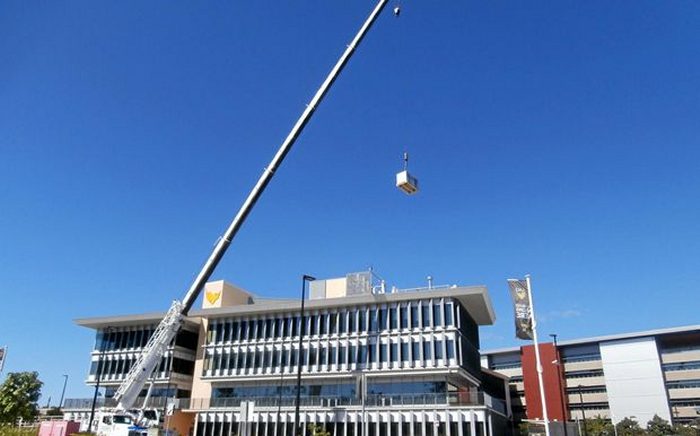
Solar panels lifted onto the roof of USQ Springfield’s Building B
Stage two of University of Southern Queensland’s Sustainable Energy Solution project is well under way, with solar panels being installed on rooftops at USQ’s Springfield and Ipswich campuses.
The second stage is expected to be completed before the end of this year. The completed Sustainable Energy Solution project will save the University millions on energy costs, plus reduce its total carbon emissions by around 20 per cent.
“Not only will it offset more than 2500 tonnes of carbon emissions each year and save the University up to $3.5 million over the 25 year life of the solar panels, but it also provides some valuable research, learning and teaching opportunities for our students and academics,” said USQ Vice-Chancellor Professor Geraldine Mackenzie.
Stage one of the Sustainable Energy Solution project was completed a couple of months ago, when more than 3,800 solar panels were installed above USQ Toowoomba’s largest car park. At 1.09 megawatts capacity, the Toowoomba installation is Australia’s largest solar car park array to date.
As well as generating electricity, solar car parks make better use of space on a site and the canopies provide protection from the sun for the vehicles beneath. Other significant Australian solar canopy projects we’ve mentioned this year include a 647kW project at Westfield Marion in Adelaide and an installation of 900 solar panels at shopping centre in Northam, around 97 kilometres east of Perth.
Other Environmental Efforts
Professor Mackenzie said USQ’s solar project builds on efforts to reduce the University’s environmental impact. Last year, USQ Springfield’s Building B achieved a 6 Star Green Star rating, the highest rating possible, for sustainable construction from the Green Building Council of Australia.
The University has also been making progress in improving energy, recycling and waste management and is introducing green transport initiatives.
Water conservation has also been an important focus. The University has replaced all single flush toilets with dual flush systems, saving an estimated 2.5 million litres a year. Air-conditioner water output is being used for irrigation purposes and a 16 megalitre retention basin was constructed to capture stormwater overflow for irrigation use. USQ has also re-plumbed buildings to make use of harvested rainwater.
“At USQ, we’re actively looking at ways we can minimise our environmental impact by investing in sustainable solutions that can help us better manage our carbon emissions, energy, water and waste,” said Professor Mackenzie.
Another way the University reduces environmental impact is through external education, with more than 75 percent of students studying via distance or online.

 RSS - Posts
RSS - Posts



Speak Your Mind